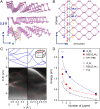The renaissance of black phosphorus
- PMID: 25820173
- PMCID: PMC4403146
- DOI: 10.1073/pnas.1416581112
The renaissance of black phosphorus
Abstract
One hundred years after its first successful synthesis in the bulk form in 1914, black phosphorus (black P) was recently rediscovered from the perspective of a 2D layered material, attracting tremendous interest from condensed matter physicists, chemists, semiconductor device engineers, and material scientists. Similar to graphite and transition metal dichalcogenides (TMDs), black P has a layered structure but with a unique puckered single-layer geometry. Because the direct electronic band gap of thin film black P can be varied from 0.3 eV to around 2 eV, depending on its film thickness, and because of its high carrier mobility and anisotropic in-plane properties, black P is promising for novel applications in nanoelectronics and nanophotonics different from graphene and TMDs. Black P as a nanomaterial has already attracted much attention from researchers within the past year. Here, we offer our opinions on this emerging material with the goal of motivating and inspiring fellow researchers in the 2D materials community and the broad readership of PNAS to discuss and contribute to this exciting new field. We also give our perspectives on future 2D and thin film black P research directions, aiming to assist researchers coming from a variety of disciplines who are desirous of working in this exciting research field.
Keywords: 2D material; anisotropic; black phosphorus; nanoelectronic; optoelectronic.
Conflict of interest statement
The authors declare no conflict of interest.
Figures






References
-
- Li L, et al. Black phosphorus field-effect transistors. Nat Nanotechnol. 2014;9(5):372–377. - PubMed
-
- Xia F, Wang H, Jia Y. Rediscovering black phosphorus as an anisotropic layered material for optoelectronics and electronics. Nat Commun. 2014;5:4458. - PubMed
-
- Liu H, et al. Phosphorene: An unexplored 2D semiconductor with a high hole mobility. ACS Nano. 2014;8(4):4033–4041. - PubMed
-
- Koenig SP, Doganov RA, Schmidt H, Neto AHC, Özyilmaz B. Electric field effect in ultrathin black phosphorus. Appl Phys Lett. 2014;104(10):103106.
-
- Rodin AS, Carvalho A, Castro Neto AH. Strain-induced gap modification in black phosphorus. Phys Rev Lett. 2014;112(17):176801. - PubMed
Publication types
LinkOut - more resources
Full Text Sources
Other Literature Sources
Miscellaneous

